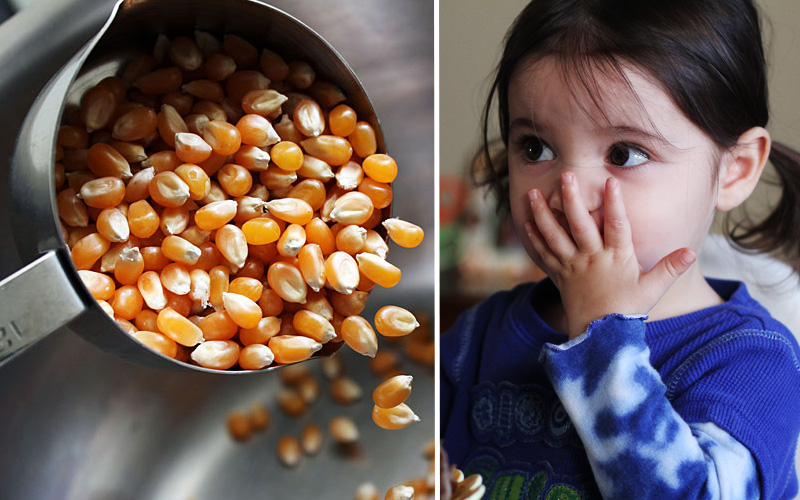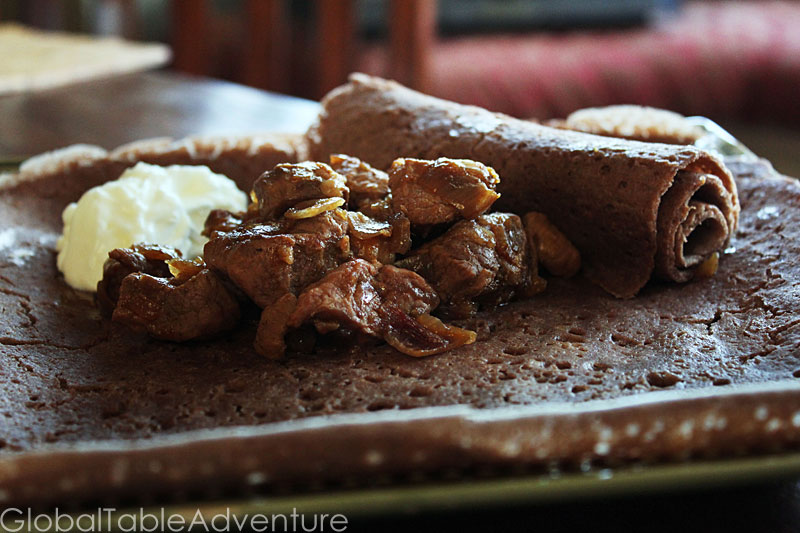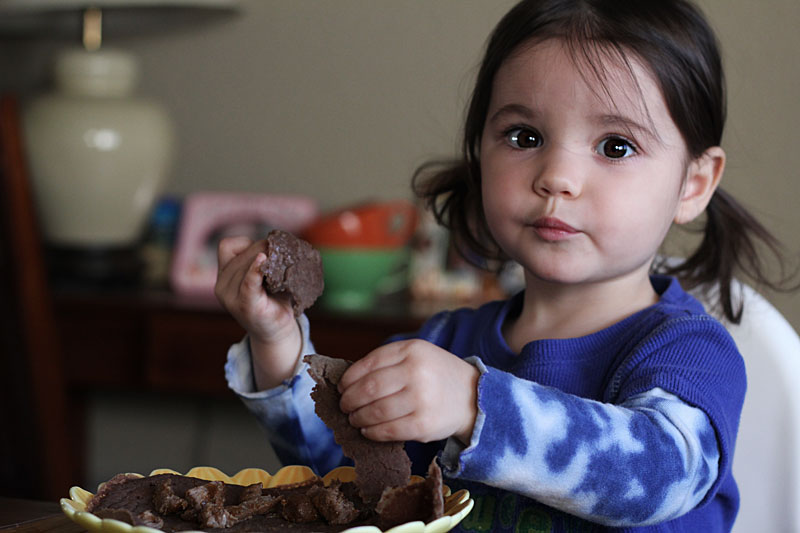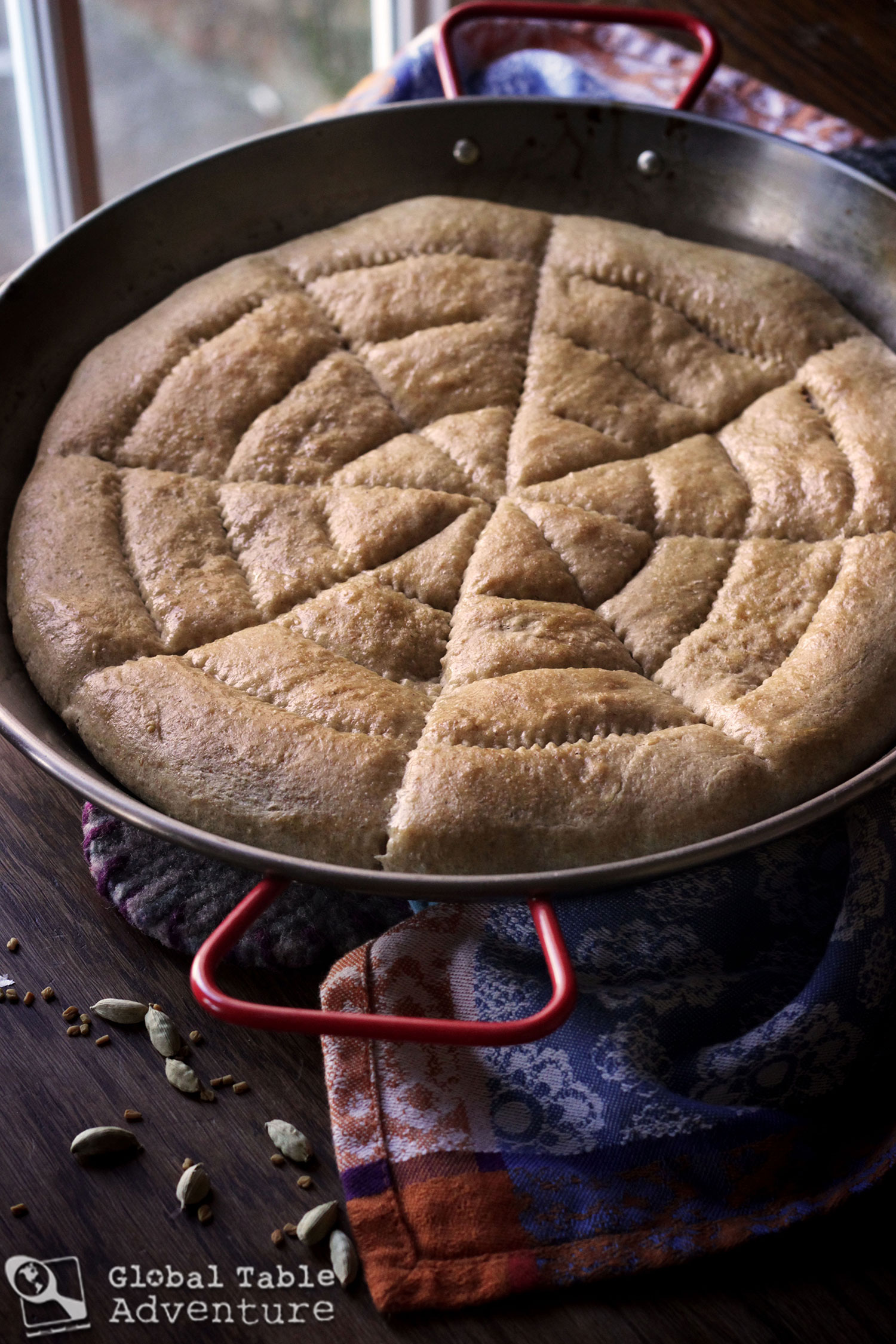
This year Ava and I brought a loaf of Eritrean Hembesha bread to the annual Martin Luther King parade. It’s a random sort of thing to bring to a parade, but I’d just pulled batch #3 out of the oven and couldn’t stand the thought of the bread cooling down without being able to enjoy a still-steaming, soft wedge. There are few things better than a steaming-hot piece of homemade bread. Hembesha is no exception: the east African bread is soft and earthy with whispers of garlic, coriander, cardamom, and fenugreek. The distinct flavor profile is great with hearty stews or even on the side of scrambled eggs (perfect for a savory brunch). That being said, hembesha is traditionally served in the afternoon with tea and a drizzle of honey and/or tesmi (tesemi is spiced ghee made with ginger, garlic, onions, and berbere) While original recipes decorate the flat loaves with nails, I’ve used a ravioli wheel (the idea came from the blog Yesterdish). I learned the hard way – don’t just score the dough – cut through 99-100% of the …
Read More
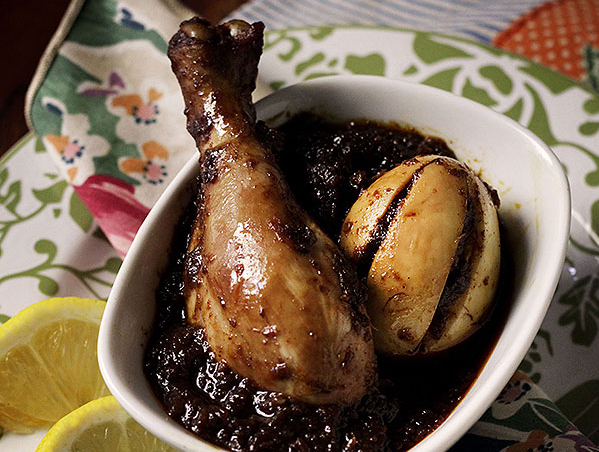
There’s been a movement to make Enkutatash – a.k.a. Ethiopian New Year – as popular as St. Patrick’s Day or Cinco de Mayo. But instead of wearing green or dancing to a mariachi band you’re invited for a much simpler, down to earth sort of celebration. Wear white. Pick yellow daisies. And enjoy traditional Ethiopian food. Waaaay back when “Enkutatash” literally stands for “gift of jewels.” As the story goes, several thousand years ago the Queen of Sheba delivered more than 4.5 tons of gold and as many spices to King Solomon. King Solomon was quite the host as he, too, showered her with gifts: …in return, King Solomon had assembled an array of gifts for her arrival. Great caskets of sticky Nubian millet beer awaited her party. The gifts were staked on mules outside Solomon’s palace, ready for her people to take to their camp and enjoy. Silks and linens from Gaza, Assyria, and Lebanon. Tapestry from Ma-Wara-Mnar. Dresses, sweet fruit from Iraq, Mongolistan winter melons. And basins of water from the spring at Siloe. Following …
Read More
THE SCENE Popcorn. The final frontier. I traced my fingers along the counter tops, navigating between a giant red bowl and a small plastic bag filled with popcorn kernels. I stopped when I reached the spot the microwave was supposed to be. About this time last year, early one Saturday morning, I had a minor meltdown (in my baby blue bathrobe and fuzzy slippers, no less). I was bleary eyed. My head hurt. All I wanted in the whole, wide world was a giant mug of hot chai tea with milk. I walked into the kitchen and literally couldn’t see the counters for the appliances. Stuff was everywhere. I could almost feel all 3.75 walls of my tiny windowless kitchen closing in on me. I started crying. All thoughts of tea forgotten, I hastily unplugged the microwave, my bread machine, and coffee maker. I began taking them, one by one, to the curb. (If I know how to do anything, it is how to be impulsive and overtaken by emotion.) Mr Picky stumbled into the …
Read More
Serves 2-4 I was a total lamb newb before starting Global Table Adventure – I simply had never cooked it. Sure, I grew up eating it with mint jelly (although the jelly always stayed on my plate, untouched), but the actual process of making a tasty meal out of lamb was a mystery to me. Thanks to our Adventure, it’s becoming rather second nature and this Ethiopian recipe might be my favorite lamb recipe thus far (barely edging out the Roast Lamb from Cyprus). Our recipe is adapted from Laura Kelley of Silk Road Gourmet, a most wonderful author and world traveler. Serve with Injera. Ingredients: 1/8 cup peanut oil 2 red onions, chopped 1 inch fresh ginger, peeled and grated (about 1 1/2 tsp) 3 cloves garlic, crushed 2 tsp berberé 1 cup beef stock 1.2 lbs cubed lamb yogurt, to taste Method: Chop the onions (you can do a large dice or strips) and cook them until golden (10-15 min) over medium high, or until you can no longer stand how good the …
Read More
Makes 4 quarts Stovetop popcorn is a must have if you’re looking to replicate an Ethiopian coffee ceremony. Sure, you could pop a bag in the microwave in less than three minutes, but… well… sometimes it’s more fun realizing how much you can do without special gadgets and gizmos. As far as who had more fun with this – me, Mr. Picky, or Miss Ava – it might have been me. I spent most of the time squealing while I waited for the first few to explode… I mean… pop. Also? I ate the most. Ingredients: 3 Tbsp vegetable oil 1/2 cup popcorn kernels salt Method: Popcorn needs to be made in a large pot, so there’s room for all the kernels to pop into white, fluffy snack goodness. It’s a lot like the heart – the bigger our hearts, the more room for all of 0ur emotions to … well… pop into white, fluffy bursts of life. With an open heart we experience so much more. Never let your heart run out of room. …
Read More
If one must eat meat raw it is surely best done in this way, for the sauce gives the impression of being hot enough to cook the meat right on the tongue. – Laurens Van Der Post (as quoted in Ethiopia, Cultures of the World by Steven Gish, Winnie Thai, and Zawiah Latif) Van Der Post is talking about an Ethiopian raw beef dish called kitfo (kit-foh). The sauce is made almost entirely of berberé – the crazy, smoke alarm hot spice blend we made recently – as well as lemon juice and a buttery-good mixture of sautéed peppers, onions, ginger, garlic, and cardamom. And, of course, raw beef. Now, for the moment of truth… would you eat it? Why or why not? Photo: Diádoco
Read More

Coffee is said to have originated in Ethiopia. Today Ethiopian coffee ceremonies are common after large meals, even at restaurants. Women will roast beans in front of the guests. Then she’ll grind the beans, perfuming the room, and brew them in a clay coffee pot, or jebena. The coffee is served in small cups called si’ni. Diners have their choice of salt or sugar. Traditionally, every guest is offered 3 cupfuls- the same grounds being brewed each time, making each consecutive cup weaker. My Rendition At best, I was ill-prepared to perform an Ethiopian coffee ceremony. #1, I live in Tulsa, Oklahoma. #2, I lack every single piece of traditional Ethiopian coffee-making equipment there could possibly be. In fact, the only proper element I have is a bag of green coffee beans. Tilda’s parents brought them all the way over from Ethiopia, known as the birthplace of coffee. At least the coffee was right. I got to work, putting my college nickname “MacGyver” to good use. What follows are the results of a free-spirited, improvisational coffee …
Read More
One of my mom’s favorite expressions is “Did you get it straight from the horse’s mouth?” She likes to ask me this when I am at my most panicked, assumption-burdened self. While the image it conjures up isn’t exactly pretty, the saying gives me perspective when I need it most. If there was ever any doubt about the food of Ethiopia, I’m going to put it to rest right now. I cooked, I ate and I am here to tell you that the food of Ethiopia is intense, flavorful, and fit for any dinner party. You can say you got it straight from the horse’s mouth. Better yet, you can make some of the food from this menu and find out for yourself. Eating without utensils is quickly becoming a favorite hobby of mine. If the potential mess scares you, have no fear. Ava will be happy to give you a lesson. She’s a pro (although, technically, the left hand is never used for eating in Ethiopia. It’s called the unclean hand and I’ll leave …
Read More

One of Miss Ava’s friends, Tilda, is from Ethiopia. While she’s not exactly talking yet (she turned one in December), her parents are talking and everything they’ve said about Ethiopia makes me hungry. They adopted Tilda last year and spent some time in the country getting to know the culture and, of course, the food. Here’s the summary: if you’re into spices, you’re in luck. They brought back bags of berberé seasoning – so much, in fact, that they didn’t think twice about giving me an entire cup of their precious stash. Almost everything is spiced with berberé seasoning [Recipe], especially the standard wat (stew) made from lamb [Recipe], chicken, lentils, or beans. Be sure to enjoy Wat with Injera [Recipe], teff pancakes that are used to scoop up the food instead of silverware. Now, for something that Tilda’s parents did not tell me – I got this little nugget from Andrew Zimmern. In his Ethiopian episode he shares that if you’re really lucky Ethiopians will offer you raw meat. Raw meat is a delicacy – the fresher …
Read More
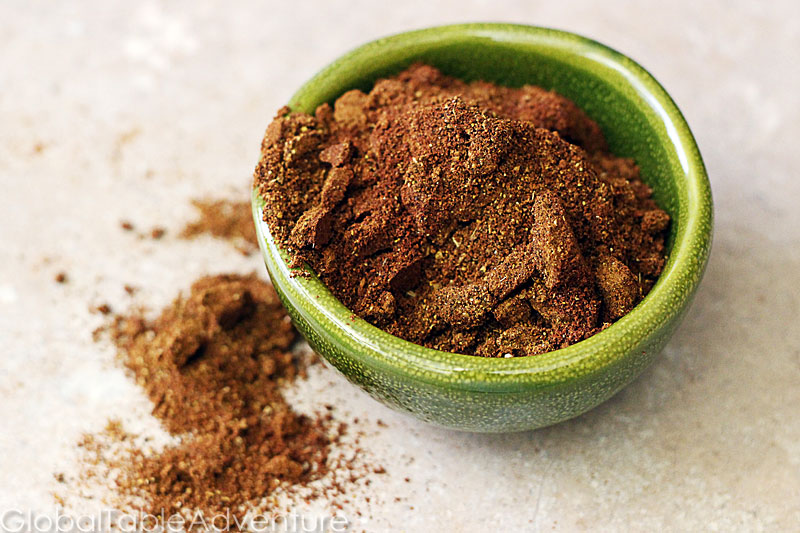
Berberé is a spicy and savory spice mixture used all over Eritrea and Ethiopia. This blend goes well with chicken, beef, or lamb, and would also be great with lentils and other legumes. I’ve used it with our Doro Wat (chicken stew) and Awaze Tibs (lamb stew) recipes. A few sprinkles would also be great in our Lentil Wat. Makes about 1/4 cup Ingredients: 3 cloves 1/2 tsp coriander seeds 1/2 tsp fenugreek seeds 1 tsp cumin 1 Tbsp paprika 1/4 tsp peppercorns 1/4 tsp ground ginger 1/4 tsp ground cinnamon 1/4 tsp ground turmeric 5 whole allspice balls 1/4 tsp cardamom seeds (removed from pods) 1/8 cup chili powder Method: Heat the spices in a clean, dry skillet to toast them. Once cool, grind them in batches. Keep going until most of the stragglers get ground up! Hey, that’s my sister! Enjoy. Berberé |Hot East African Spice blend Votes: 0 Rating: 0 You: Rate this recipe! Print Recipe Berberé is a spicy and savory spice mixture used all over Eritrea and Ethiopia. This blend goes well with …
Read More

Do you dream of cleaning out your cluttered silverware drawer? Are you totally tired of your dishes? Try a happy bite of Injera, the gorgeous Teff flatbread adored in Eritrea, Ethopia, and other East African countries. Sour and funky… Injera is almost as thin as a crepe, but spongy like a pancake … and is traditionally used both as a platter for spicy stews and to replace silverware. Three tips for foolproof Injera making: 1. Consistency Make sure the batter is almost the consistency of crêpe batter (between crêpes and pancakes) . Any thinner and the bubbles won’t form. Much thicker and it won’t look like traditional Injera. Practice makes perfect. 2. The Pan If you don’t have the traditional mitad (I didn’t), you can use a large, short sided pan. You’ll have the best luck with a nonstick pan or a really well seasoned crêpe pan. Cover loosely with aluminum foil if it doesn’t have a lid. 3. Play it cool Absolutely cool the Injera before stacking or attempting to move it around much. They are …
Read More



